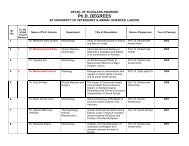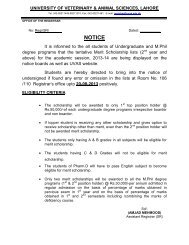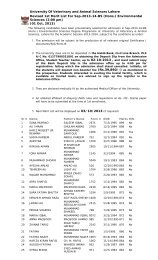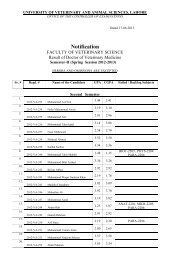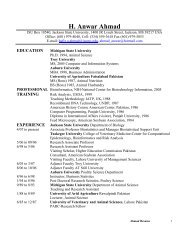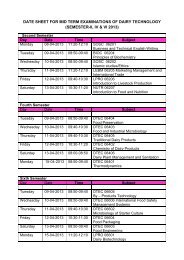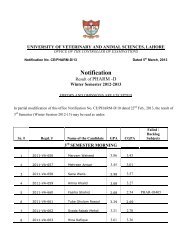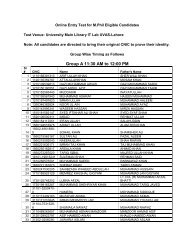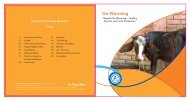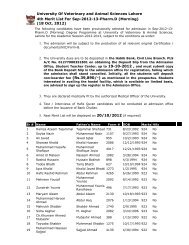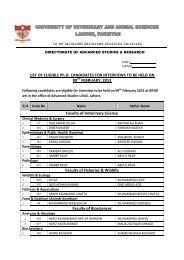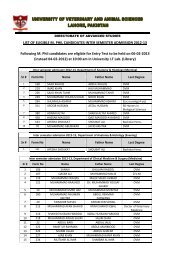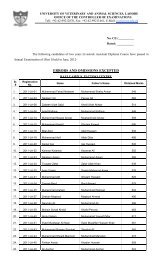Download Presentation
Download Presentation
Download Presentation
Create successful ePaper yourself
Turn your PDF publications into a flip-book with our unique Google optimized e-Paper software.
ASIM MAJID KHAN<br />
Chief Instructor,<br />
National Institute of Management, Lahore.<br />
March 16, 2011<br />
1
Outline<br />
• Past Performance 1947 - 2010<br />
• Recent Economic downturn<br />
• Where do we want to see Pakistan in the next<br />
ten years<br />
• Demographic Challenges<br />
• Addressing these challenges<br />
2
Additions to GDP – Various Periods<br />
Ayub ZAB Zia BB NS BB NS Mush Zardari<br />
3
1947 -- 1958<br />
STRUCTURE;<br />
• AGRICULTURE 53%,<br />
• SERVICES,39%,<br />
• INDUSTRY 8%.<br />
GDP GROWTH AVERAGE 3.2%<br />
• INDUSTRY 9.6%<br />
POLICY OF IMPORT SUBSTITUTION HIGH<br />
PROTECTION<br />
4<br />
Continue
• LICENCING SYSTEM, OFFICIAL<br />
EXCHANGE RATE<br />
• CONTROLLED LOW INTEREST RATES<br />
• LOW AGRICULTURAL PRICES<br />
• HIGH INDUSTRIAL PROFITS<br />
• KOREAN WAR BOOM<br />
5
AYUB 1958 -- 1969<br />
AGRICULTURE 41.5%,<br />
INDUSTRY 15%,<br />
SERVICES 42%<br />
GROWTH 6%<br />
MANUFACTURING 9.1%,<br />
Continue<br />
6
• GREEN REVOLUTION SEEDS, FERTILIZERS, AND<br />
MECHANISATION<br />
• MANGLA DAM, TUBEWELLS<br />
• FIVE YEAR PLANS DRIVN BY PRIVATE SECTOR<br />
• BONUS VOUCHER SYSTEM MULTI[PLE<br />
EXCHANGE RATES<br />
• CHEAP CREDIT<br />
• PIDC<br />
Continue<br />
7
• DEVELOPMENT OF ENTREPRENEUR<br />
CLASS – 22 FAMILIES<br />
• SEATO CENTO FOREIGN AID TO<br />
BRIDGE INVESTMENT SAVING GAP<br />
• 1965 WAR<br />
8
Bhutto and Socialism 1971--77<br />
• GDP GROWTH 5%<br />
• AGRICULTURE 2.3%<br />
• INDUSTRY 3.2%<br />
• DEVALUATION<br />
• NATIONALIZATION PRIVATE<br />
INVESTMENT COLLAPSED<br />
9
• DESTRUCTION OF LARGE GROUPS<br />
• INFLATION 26.7% 1974-75<br />
• HIGH PUBLIC DEBT<br />
• REMITTANCES AND OIL PRICES<br />
10
ZIA 1977 -- 1988<br />
• GDP GROWTH 6%<br />
• AGRICULTURE 4.1%<br />
• INDUSTRY 8.8 %<br />
• AFGHAN WAR AID<br />
• REMITTANCES<br />
• FISCAL DEFICITS 8%<br />
11
• INFLATION 8%<br />
• SOME DEREGULATION AND<br />
LIBERALIZATION<br />
• STARTING DENATIONALIZATION<br />
• COTTON PRODUCTION – NEW SEEDS<br />
12
THE LOST DECADE 1989--1999<br />
• GDP GROWTH 4%<br />
• AGRICULTURE 3.3%<br />
• Industry 5.9%<br />
• ACCELARATED PRIVATIZATION<br />
• FINANCIAL REFORMS<br />
• END OF AFGHAN WAR REDUCTION IN<br />
AID continue 13
• POLITICAL MUSICAL CHAIRS<br />
INCONSISTENT POLICY.<br />
• NUCLEAR EXPLOSION AND<br />
IMPOSITION OF SANCTIONS<br />
• SELECTIVE DEFAULT<br />
14
Macroeconomic Performance in Pakistan:<br />
Historical Perspective<br />
Growth (%) 1960's 1970's 1980's 1990's<br />
GDP 6.8 4.8 6.5 4.6<br />
- Agriculture 5.1 2.4 5.4 4.4<br />
- Manufacturing 9.9 5.5 8.2 4.8<br />
- Services 6.7 6.3 6.7 4.6<br />
Share (%) in GDP<br />
Total Investment - 17.1 18.7 18.3<br />
National Savings - 11.2 14.8 13.8<br />
Total Revenue 13.1 16.8 17.3 16.9<br />
Total Expenditure 11.6 21.5 24.9 24.1<br />
Budget Deficit 2.1 5.3 7.1 6.9 15
Macroeconomic Performance in Pakistan:<br />
Historical Perspective<br />
Share (%) in GDP 1960's 1970's 1980's 1990's<br />
Total Exports - - 9.8 13.0<br />
Total Imports - - 18.7 17.4<br />
Trade Deficit - - 8.9 4.4<br />
Current Account Deficit - - 3.9 4.5<br />
Human Resources/ Social Development<br />
Un-employment Rate - - 1.4 5.7<br />
Literacy Rate - - 29.5 40.7<br />
Male - - 39.0 51.6<br />
Female - - 18.7 28.6<br />
Expenditure on Education - - 0.8 2.3<br />
Expenditure on Health - 0.6 0.8 0.7<br />
16
1999–2007<br />
MAJOR<br />
ECONOMIC<br />
REFORMS<br />
17
Real GDP Growth<br />
Real GDP growth (% change)<br />
Source: Ministry of Finance 18
Investment rate started declining<br />
again<br />
Investment recovered strongly to an average of 26.4% p.a. during 2004<br />
-2007 registered the largest decline in Pakistan history in 2009<br />
Source: Various Issues of Economic Survey<br />
19
Recent Trends Remittances ($ Million)<br />
20
Yearly Changes in Net Credit to The private<br />
Sector<br />
21
Agriculture Credit<br />
Disbursement of Agricultural<br />
Credit<br />
22
The country remained vulnerable to external shocks as Forex<br />
Reserves plummeted by the end of the 1990s (US $ billion)<br />
Foreign Exchange Reserves recently were in comfortable zone<br />
Imf loans<br />
$6 b<br />
Source: SBP<br />
23
Federal Tax Collection (Billion $)<br />
* Projection<br />
24
Development Spending (Billion $)<br />
3.5b<br />
* Projection<br />
25
Electricity Consumption (GWH)<br />
* Projection<br />
26
Installed capacity (MW)<br />
27
Resource Mobilization by FBR:<br />
Time-Series<br />
Historical Evidence<br />
Collection<br />
(Millions of Rupees)<br />
Average Annual<br />
Growth Rate during the<br />
Decade (%)<br />
1948-49 310.6 1940s: 44.6<br />
1958-59 1,281 1950s: 12.9<br />
1968-69 3,902 1960s: 14.9<br />
1978-79 22,399 1970s: 21.0<br />
1988-89 91,020 1980s: 13.4<br />
1998-99 308,509 1990s: 13.0<br />
2004-05 591,085 Since 2000: 11.6<br />
2005-06 713,400 20.7<br />
2006-07 846,200 18.6<br />
Overall Growth (%) 1948-2007: 15.2<br />
28
Recent economic downturn<br />
29
OIL PRICE MOVEMENT IN US<br />
DOLLARS<br />
AND CURRENT ACCOUNT DEFICIT<br />
<br />
ELECTIONS<br />
Karachi<br />
blast<br />
IMF PROGRAM<br />
30
Oil Import Bill ($ Billion)<br />
-12.0<br />
31
Reserves from October 2007 to<br />
November 2009<br />
Millions of Dollars<br />
MCB Sale<br />
IMF Program<br />
32
Foreign Investment (US $ million)<br />
Foreign Investment was Rising Sharply: touched 5.8% of GDP in 2006-07<br />
Source: SBP<br />
33
Exchange Rate Movement (Rs/US $)<br />
Pakistan’s exchange rate has appreciated during July 01 until April 04; depreciated a bit<br />
and since March 2005 onward had remained stable until ……<br />
85.5<br />
Sept. 2001<br />
Oct. 2004<br />
Apr. 2004<br />
34
Debt servicing (Rs millions)<br />
35
Internal debt (Rs billion)<br />
FOREIGN DEBT INCREASED TO USD 56 BILLION 36
PUBLIC DEBT (As % of GDP)<br />
60.0<br />
37
Inflation remained in the double digit during<br />
most of the period in the 1990’s<br />
Inflation (%) (Base year 2001 = 100)<br />
25<br />
%<br />
Source: FBS<br />
38
Progress is Reflected in the Ratings<br />
Momentum on Pakistan<br />
B<br />
3<br />
B-<br />
39
A GLANCE AT CURRENT PUBLIC<br />
FINANCE POSITIONS<br />
(FEDERAL AND PROVINCIAL CONSOLIDATED)<br />
• Revenue Side<br />
• Tax Revenue<br />
– Federal<br />
– Provincial<br />
• Non-Tax Revenue<br />
– Federal<br />
– provincial<br />
• Expenditure Side<br />
• Current<br />
– Federal<br />
– Provincial<br />
• Development (PSDP)<br />
• Net Lending to PSEs<br />
• Statistical<br />
Discrepancy<br />
40
SUMMARY OF FEDERAL BUDGETARY POSITION<br />
FY: 2009- 10 (BE)<br />
RECEIPTS EXPENDITURE<br />
A. Tax Revenue* (73.9%) D. Current Expenditure<br />
(78.6%)<br />
B. Non-Tax Revenue (26.1%) E. Development<br />
Expenditure<br />
Including Surcharge on (PSDP) (21.4%)<br />
1. Natural Gas<br />
2. Petroleum<br />
41
SOURCES OF<br />
Provincial / District Government Taxes<br />
o Direct Taxes<br />
Land Revenue<br />
Urban Immovable Property Tax<br />
Tax on Transfer of Property<br />
Agriculture Income Tax<br />
Capital Gains Tax<br />
Tax on Professions, Trade, and Callings<br />
continue<br />
42
o Indirect Taxes<br />
Stamp Duty<br />
Motor Vehicle Tax<br />
Entertainment Tax<br />
Provincial Excise Duties<br />
Misc. Duties (cotton duty etc.)<br />
43
A Quick Review of Consolidated Public<br />
Finance (Rs. Billion)<br />
44<br />
Source: PES 2009-10 & SBP Annual Report 2009-10
Growth in<br />
Fiscal Sector Variables (Percent)<br />
45
Structure of Federal Taxes<br />
Year<br />
FBR Revenue<br />
(Rs. Billion)<br />
Tax/GDP<br />
Ra9o<br />
1990‐91 111.0 11.0<br />
1996‐97 282.0 12.0<br />
1997‐98 293.7 11.0<br />
1998‐99 308.5 10.0<br />
1999‐00 346.6 9.1<br />
2000‐01 392.3 9.4<br />
2001‐02 403.9 9.2<br />
2002‐03 460.6 9.6<br />
Indirect Taxes<br />
Direct Taxes Customs Sales Excise Total<br />
20.0 50.0 16.0 25.0 91.0<br />
[18.0]* (54.9)^ (17.6)^ (27.5)^ [82.0]*<br />
85.0 86.0 56.0 55.0 197.0<br />
[30.1] [43.6] [28.4] [27.9] [69.9]<br />
103.0 74.5 53.9 62.0 190.4<br />
[35.0] [39.1] [28.3] [32.6] [65.0]<br />
110.4 65.0 72.0 60.8 198.1<br />
[35.8] [33] [36.3] [30.7] [64.2]<br />
112.6 61.6 116.7 55.6 234.0<br />
[32.5] [26.4] [49.9] [23.7] [67.5]<br />
124.6 65.0 153.6 49.1 267.7<br />
[31.8] [24.3] [57.4] [18.3] [68.2]<br />
142.5 47.8 166.6 47.2 261.6<br />
[35.3] [18.3] [63.7] [18] [64.7]<br />
148.5 59.0 205.7 47.5 312.2<br />
[32.2] [18.9] [65.9] [15.2] [67.8] 46<br />
Continued
Structure of Federal Taxes<br />
Year<br />
FBR<br />
Tax/GDP<br />
Revenue<br />
Ra9o<br />
(Rs. Billion)<br />
Direct<br />
Taxes<br />
Indirect Taxes<br />
Customs Sales Excise Total<br />
2003‐04 518.8 9.2<br />
2004‐05 588.4 9.1<br />
2005‐06 713.4 9.4<br />
2006‐07 847.2 9.8<br />
165.3 89.9 219.1 44.6 353.6<br />
[31.9] [25.4] [62] [12.6] [68.1]<br />
176.9 117 235.5 58.7 411.4<br />
[30.1] [28.5] [57.2] [14.3] [68.9]<br />
224.6 138 294.6 55 487.9<br />
[31.5] [28.3] [60.4] [11.3] [68.5]<br />
333.7 132.3 309.4 71.8 513.5<br />
[39.4] [25.8] [60.3] [13.9] [60.6]<br />
2007‐08 1007 9.8 [39.6] [24.7] [60.3] [14.6] [60.4]<br />
2008‐09 1161 9.1<br />
2009‐10 1327.7 9.1<br />
443.5 148.4 451.8 117.5 717.7<br />
[39.6] [22.5] [62.5] [14.8] [60.4]<br />
528.9 161.5 516.1 121.2 798.8<br />
[39.8] [20.2] [64.6] [15.1] [60.2]<br />
47
Review of Provincial Budget<br />
Items<br />
Punjab Sindh KP Baluchistan Total<br />
07‐08 08‐09 07‐08 08‐09 07‐08 08‐09 07‐08 08‐09 07‐08 08‐09<br />
RE BE RE BE RE BE RE BE RE BE<br />
A. Total Tax Revenue 256.4 329.9 158 188.7 59.1 76.2 30.7 35.2 504.1 630<br />
Provincial Taxes 30.6 40.4 16.4 19.8 2.4 3.9 0.9 1 50.3 65.1<br />
Share in Federal Taxes 225.8 289.6 141.6 168.9 56.7 72.2 29.8 34.2 453.8 564.9<br />
B. Non‐Tax Revenue 42.2 36.6 12.1 10.5 3.1 3.5 2.3 2.5 59.6 53.1<br />
C. All Others 6.2 7.3 8.7 12.8 17.5 20.7 15.8 14.8 48.2 55.5<br />
Total Revenues (A + B +C) 304.7 373.8 178.7 211.9 79.7 100.4 48.8 52.2 611.9 738.6<br />
a) Current Expenditure 232.2 257 163.9 181 61.5 67.3 40 47.5 497.5 552.8<br />
b) Development<br />
Expenditure 138 160 62.3 77.3 32.9 41.6 28.8 15.7 262 294.7<br />
Total Exp (a + b) 370.2 417 226.2 258.3 94.4 108.9 68.8 63.3 759.5 847.4<br />
Prov. Taxes as percentage of<br />
Total Tax Revenue 11.9 12.2 10.4 10.5 4.1 5.1 2.9 2.8 10.0 10.3<br />
Total Expenditure 8.3 9.7 7.3 7.7 2.5 3.6 1.3 1.6 6.6 7.7<br />
48
Relatively Recent Macroeconomic<br />
Performance<br />
BD<br />
7.6,<br />
4.3<br />
TD<br />
9.3, 6.5<br />
CAD<br />
8.5, 5.1<br />
49
Relatively Recent Macroeconomic<br />
Performance<br />
TI<br />
22, 19.7<br />
TR<br />
14.6,<br />
14.6<br />
TE<br />
22.2,<br />
18.6<br />
TX<br />
12.2, 9.6<br />
TM<br />
21.5,<br />
16.1<br />
50
REVENUE, EXPENDITURE AND<br />
DEFICIT SITUATION<br />
GDP<br />
At Market Prices<br />
(Rs. Billion)<br />
Total<br />
Revenue<br />
Total<br />
Expenditure<br />
Percentage of GDP<br />
Overall<br />
Budget Deficit<br />
Primary Balance<br />
(TR – NI Exp)<br />
1999-00 3,826 13.5 18.8 5.4 1.7<br />
2000-01 4,210 13.3 17.4 4.3 2.2<br />
2001-02 4,453 14.2 18.3 4.3 1.6<br />
2002-03 4,876 14.9 18.5 3.7 0.5<br />
2003-04 5,641 14.3 16.7 2.4 1.1<br />
2004-05 6,500 13.8 17.2 3.3 0.04<br />
2005-06 7,623 14.2 18.5 4.3 -0.8<br />
2006-07 8,723 14.9 19.1 4.3 -1.3<br />
2007-08<br />
2008-09<br />
10,282<br />
13,095<br />
14.6<br />
14.6<br />
22.1<br />
18.6<br />
7.4<br />
4.3<br />
-2.8<br />
0.8 51
ECONOMIC CHALLENGES
Challenges<br />
After a period of reasonable growth (2002-07),<br />
Pakistan economy began experiencing severe<br />
difficulties beginning late 2007 as the economy hit<br />
by 4 crises:<br />
– Unsustainable policy-induced imbalances in the<br />
economy, leading to a macroeconomic crisis<br />
– An external terms of trade shock, with the<br />
extraordinary rise in food and prices in 2008<br />
– The global financial crisis, which greatly amplified<br />
the negative effects on the economy<br />
– Intensification of war on terror<br />
53
Economy-Backdrop<br />
(Cont…)<br />
As a result:<br />
– The fiscal deficit rose to 7.6% in 2007-08<br />
– The current account deficit surged to a record<br />
8.5% of GDP;<br />
– Inflation touched 25% at its peak, in August<br />
2008;<br />
– SBP’s foreign exchange reserves depleted from<br />
$14.2 billion in October 2007 to $3.4 billion<br />
October 2008 (One month import cover)<br />
– Rupee lost 22% of its value between March and<br />
October 2008<br />
54
Macroeconomic Challenges<br />
Growth Deceleration with consequences of income<br />
erosion, unemployment and poverty<br />
Unsustainable revenue-expenditure gap<br />
Structural imbalances because of:<br />
• Low savings rate, low tax-to-GDP ratio and growing<br />
demand for expenditures<br />
• Domestic resource scarcity is financed by foreign<br />
savings<br />
Rising Inflation because of supply shocks and monetary<br />
overhang<br />
Fiscal and monetary tightening: Impact on growth<br />
55<br />
Rising Cost of Production and industrial competitiveness
Measures to Regain Macroeconomic Stability<br />
In response, the government committed itself to<br />
restoring macroeconomic stability<br />
Adoption of stabilization program at the time of<br />
Budget 2008-09<br />
Fiscal deficit target with strong adjustments in the<br />
petroleum and electricity prices<br />
Tariff adjustments and expenditure cuts made to<br />
reduce aggregate demand;<br />
Tight monetary policy to contain inflationary spiral; 56
Measures to Regain Macroeconomic<br />
Stability<br />
(Cont…)<br />
Prioritized the development expenditures<br />
Program for elimination of subsidies on<br />
food, fuel and power adopted<br />
Zero net borrowing from SBP for budget<br />
financing<br />
Tax administration reforms<br />
Pakistan negotiated SBA with the IMF in<br />
Nov-2008 to get required support.<br />
57
DEMOGRAPHIC CHALLENGES
Source: World Bank<br />
59<br />
59
Unequal States – Income inequality<br />
Source: London Economist 2008. Asian Development bank<br />
60
Pakistan is assured of a Demographic<br />
Dividend by investing in Human capital<br />
101.6 million (63%) Pakistanis are less than 25 years old<br />
Source : Economic Survey 2004-05, 2005-06; House Hold Survey 2004-05<br />
61
A Young And Growing Population:<br />
Increasing Consumerism<br />
62
Emergence of a strong middle<br />
class<br />
Household Income Distribution (%)<br />
Average Growth per annum in selected<br />
consumer durables since June 1999<br />
Lowest 20% Middle 60% Highest 20%<br />
Source : Economic Survey 2004-05, 2005-06; House Hold Survey 2004-05 63
Strategic Demographic Highlights:<br />
Compelling Economic Proposition<br />
Rising disposable income<br />
Growing population<br />
Compelling size of middle class<br />
Asset values rising<br />
Rising remittances<br />
Low cost raw materials & manpower<br />
Motivated work force<br />
Pro investment policies<br />
Improving infrastructure<br />
Entrepreneur culture<br />
Stable exchange rate<br />
Accelerating Consumerism<br />
Surging Domestic & Foreign<br />
Investment<br />
Comparable advantage<br />
Favorable geographical location<br />
Corporates globalizing<br />
Low tariff regime<br />
Growing Trade Intensity<br />
And export competitiveness<br />
64
Per Capita Income ($)<br />
65
Foreign Investment ($ Million)<br />
Foreign Private Investment<br />
- Foreign Direct Investment<br />
- FDI (Excl Privatization Proceeds)<br />
- Portfolio Investment<br />
July-October<br />
2008-09 2009-10 (%) Change<br />
1,172.5 940.4 -19.8<br />
1,329.5 621.8 -53.2<br />
1,329.5 621.8 -53.2<br />
-157.1 318.7 302.9<br />
Foreign Public Investment -16.8 -30.3 -<br />
Total 1,155.7 910.1 -21.2<br />
Source: SBP
Workers’ Remittances ($ Million)<br />
July-November<br />
2009 2010<br />
(%) Change<br />
Total 2,966.5 3,832.6 29.2<br />
USA 767.1 797.2 3.9<br />
Saudi Arabia 600.2 708.4 18.0<br />
UAE 534.2 854.2 59.9<br />
Other GCC Countries 496.2 544.9 9.8<br />
U.K 189.0 408.5 116.2<br />
EU Countries 81.0 123.9 52.9<br />
Other Countries 230.7 294.6 27.7<br />
• Source: SBP
Strategy for Demographic Dividend<br />
Attaining 7-8% growth<br />
Pillar I: Macroeconomic Stability and Sectoral<br />
Drivers of Economic Growth (Agriculture,<br />
manufacturing, services, Minerals)<br />
Pillar II: Crafting a Competitive Advantage for<br />
Domestic and Global Markets<br />
Pillar III: Harnessing the Potential of the People<br />
& employment generation<br />
68<br />
Continue
• Pillar IV: Financial Sector Deepening<br />
and Economic Development<br />
• Pillar V: World Class Infrastructure<br />
(Water, Hydel Power, logistics & cities)<br />
• Pillar VI: Effective Governance and<br />
Management<br />
• Pillar VII: Targeting the Poor and the<br />
Vulnerable<br />
69
Energy Challenges<br />
• Immediate improvement of Governance and<br />
Credibility required<br />
• Starting major hydel power projects particularly<br />
Kalabagh that can generate 3600 MW and can<br />
supply power as early as 2013 –<br />
• Cost of this power will be less than Rs 1.5 /Kwh<br />
substantially reduce the oil consumption<br />
70<br />
Continue
• Eliminate subsidies<br />
• Ensure continuity of Financial flows into<br />
the country<br />
• Reduce the political risk premium of the<br />
country by reducing tensions and<br />
generating reconciliation<br />
• Export Push and greater market access<br />
into USA and EU<br />
71<br />
Continue
• Public private partnerships for<br />
infrastructure<br />
• Privatization of White elephants and<br />
deregulate economy<br />
• Revival of investment reduce cost of<br />
capital to single digits<br />
72
FISCAL CHALLENGES<br />
73
Real GDP Growth (%)<br />
Source: FBS 74
Structure of Expenditure (% Share)<br />
Items<br />
2005-06 2006-07 2007-08 2008-09 2009-10<br />
BE<br />
Current 77.8 79.5 85.2 88.9 81.0<br />
Interest 23.5 30.1 30.6 35.8 30.2<br />
Defence 24.0 20.4 17.8 17.8 16.0<br />
Running of Civil Govt +<br />
Pension 14.0 16.4 11.3 11.9 11.0<br />
Subsidies 6.3 6.0 20.0 15.7 9.1<br />
Grants 10.1 6.5 5.4 7.7 14.6<br />
Development 22.2 20.5 14.8 11.1 19.0<br />
TOTAL 100.0 100.0 100.0 100.0 100.0<br />
75
Structure of Expenditure (%of GDP)<br />
Items<br />
2005-06 2006-07 2007-08 2008-09 2009-10<br />
BE<br />
Current 10.3 10.9 13.2 11.7 11.7<br />
Interest 3.1 4.1 4.8 4.7 4.4<br />
Defence 3.2 2.8 2.8 2.3 2.3<br />
Running of Civil Govt +<br />
Pension 1.8 2.3 1.8 1.6 1.6<br />
Subsidies 0.8 0.8 3.1 2.1 1.3<br />
Grants 1.3 0.9 0.8 1.0 2.1<br />
Development 2.9 2.8 2.3 1.5 2.7<br />
TOTAL 13.2 13.7 15.5 13.1 14.4<br />
76
Structure of Current Expenditure (% Share)<br />
77
Immediate Issues<br />
A sharp slowdown in economic growth has impacted<br />
government revenue, while the global financial crisis has<br />
worsened the environment for raising private external<br />
capital flows<br />
Structure of budgetary expenditures affords little flexibility:<br />
security-related expenditures + debt servicing absorb<br />
60% of government revenue<br />
In order to meet IMF program targets, GoP has resorted<br />
to development spending cutbacks – a counter-productive<br />
strategy<br />
Budget FY10 envisages substantial hike in development<br />
spending to reinvigorate economic growth (Case for fiscal<br />
78<br />
stimulus)
Revenue collection lacks vigor;<br />
Exports growth requires acceleration from current<br />
deceleration;<br />
Development spending should be increased to<br />
mitigate the economic slow down;<br />
Administrative action to align domestic prices with<br />
international trends;<br />
There may be implications for banking system in the<br />
wake of industrial slow-down and weak exports<br />
demand.<br />
Immediate Issues<br />
79
Medium Term Challenges<br />
Medium Term Challenges for Pakistan:<br />
1) Achieve successful completion of stabilization agenda<br />
2) Transit from stabilization to a sustainable, equitable<br />
and job-creating growth<br />
This will entail:<br />
– Focus on productive sectors of the economyagriculture<br />
and manufacturing<br />
– Enhancing productivity level through improvements to<br />
human capital base and physical infrastructure<br />
– Ensuring availability of cost-effective energy<br />
80
Medium Term Challenges (Cont…)<br />
– Enhanced market access for Pakistan’s exports<br />
– Galvanizing internal resources via a meaningful<br />
widening of tax base<br />
– Effectively countering the security challenge<br />
3) Rapidly enhance coverage of well-targeted<br />
social safety nets for the poor and vulnerable<br />
4) Achieve food security<br />
81
Challenges to Macroeconomic projections<br />
Risks to the Economy<br />
Slower recovery in trading partners will lead to<br />
lower demand for exports, lower workers<br />
remittances<br />
Delay in donor support will delay countercyclical<br />
fiscal policy (US$ 5.7 bill.)<br />
High commodity prices<br />
Adverse security environment<br />
FBR revenues-VAT<br />
82
Pressing Macroeconomic Issues<br />
• High Trade Deficit and Rising CAD<br />
– Poor export performance, paying price for<br />
heavy reliance on textile;<br />
– The export to import ratio declined from<br />
56% to 48%;<br />
83
• Seven items -- POL, Edible Oil, Wheat,<br />
Cotton, Fertilizer, Iron & Steel, and oil rigs<br />
had additional cost of Rs. 477.4 Billion in<br />
the overall imports of Rs. 2242.3 B till<br />
May over last year. The rest of the import<br />
bill was just a routine matter. Thus, the<br />
real concern and policy action should<br />
have revolved around these items only. 84
REVENUE GENERATION AND<br />
ITS CHALLENGES<br />
85
Foreign Trade Sector:<br />
Aggregate Position<br />
• Total Exports in 2005-06 and 2006-07 close to US $<br />
16 billion and in 2007-08 US $ 20.1 billion; July-April<br />
07-08 US$ 16.4 b and July-April 08-09 US $ 16 b.<br />
• Total Imports two years ago US $27 billion, in<br />
2007-08 around US $ 35 billion, July-April 07-08 US$ 28.7 b<br />
and July-April 08-09 US $ 26.7 b.<br />
• Resultantly the trade balance and CAD that<br />
worsened have improved slightly (8.5% from 10.1%<br />
and 5.1% from 6.7%, respectively)<br />
• Previously foreign flows in the shape of portfolio<br />
investment and FDI rescued the economy, in<br />
2007-08 draw down on reserves also.<br />
86
Export Side<br />
• Narrow concentration: Nearly 73% of total exports during<br />
July-April 2007-08 related to five commodity-groups:<br />
53% cotton manufacturers, 6.1% leather products, 7.1%<br />
rice, 2.9% synthetic textile, and 1.6% sports goods<br />
• Within cotton-group five commodities had 80% share:<br />
cotton yarn 13%, cotton cloth 18%, Knitwear 17%, Bed<br />
wear 18%, and RM Garments 14%.<br />
• There is no substantial change in this composition over<br />
the last ten years.<br />
• The destination of exports have also remained few<br />
without major changes.<br />
87
Import Side<br />
• Nearly 80% of Pakistan’s imports related to only four<br />
commodity-groups;<br />
• 40% to POL products, 16% food products, 21% raw material<br />
and only 4% machinery;<br />
• Within food-group edible-oil is the main import item<br />
followed by sugar, pulses, and tea. Last year wheat was also<br />
a big ticket item;<br />
• Within raw material, fertilizer , iron and steel scrap and<br />
chemicals have the largest weight;<br />
• The sudden rise in international prices of imported products<br />
resulted into additional import bill of nearly US $ 4 b in first<br />
ten months of 2007-08 but with the collapse of these prices<br />
the burden on national exchequer has reduced. 88
TRADE BREAKUP World vs Pakistan-2003<br />
89
Tax Heads<br />
Collection<br />
Projections<br />
Growth (%)<br />
FY: 09-10 FY: 10-11<br />
Direct Taxes 526.0 656.3 24.8<br />
Sales Tax 516.3 633.8 22.8<br />
Federal Excise 124.8 141.0 13.0<br />
Customs Duty 160.3 173.3 8.1<br />
All Taxes 1,327.4 1,604.4 20.9<br />
94
Collection<br />
Collection<br />
Growth<br />
Growth<br />
Q1: 10-11<br />
Q1: 09-10<br />
(Absolute)<br />
(Percent)<br />
Direct Taxes 95.7 85.3 10.4 12.2<br />
Sales Tax 133.7 117.1 16.6 14.2<br />
Federal Excise 26.9 28.4 -1.5 -5.2<br />
Customs Duty 37.2 33.1 4.1 12.4<br />
All Taxes 293.5 263.9 29.6 11.2<br />
95
S.No.<br />
Description<br />
Collection %<br />
Growth<br />
2010-11 2009-10<br />
1.<br />
Collection on Demand<br />
2,395<br />
10,878<br />
-78.0<br />
2.<br />
Voluntary Compliance<br />
31,805<br />
19,511<br />
63.0<br />
3.<br />
Collection at Source<br />
70,153<br />
61,749<br />
13.6<br />
4.<br />
Other Direct Taxes<br />
2,657<br />
2,244<br />
18.4<br />
Direct Taxes (Gross) 107,010 94,379 13.4<br />
Refunds 11,292 9,033 25.0<br />
Direct Taxes (Net) 95,718 85,345 12.2<br />
96
Tax Heads Q1: 10-11 Q1: 09-10 Growth (%)<br />
Contracts/ Supplies 17,314 18,089 -4.3<br />
Imports 13,663 10,366 31.8<br />
Salary 9,264 7,132 29.9<br />
Telephone use 6,085 5,264 15.6<br />
Bank Interest 4,870 4,042 20.5<br />
Exports 4,460 3,674 21.4<br />
Electricity use 3,419 3,366 1.6<br />
Cash withdrawal 2,961 2,894 2.3<br />
Dividends 1,845 1,399 31.9<br />
Sub-Total 63,881 56,225 13.6<br />
Other WHT 6,272 5,524 13.5<br />
Total WHT 70,153 61,749 13.6<br />
Share in Gross 65.6% 65.2%<br />
97
Returns/Statements<br />
FY:10-11 FY:09-10 Growth (%)<br />
Returns<br />
Corporate Cases 1,740 1,544 12.7<br />
AOPs 32,998 29,225 12.9<br />
Salaried Individuals 106,959 109,516 -2.3<br />
Non-Salaried Individuals 565,971 548,115 3.3<br />
Sub Total Returns 707,668 688,400 2.8<br />
Statements<br />
Salary certificates/statements 18,278 18,142 0.7<br />
employees statements 1,184,447 1,054,650 12.3<br />
Importers 2,116 12,212 -82.7<br />
Exporters 4,770 8,225 -42.0<br />
Retailers up to 5m turnover 13,336 13,485 -1.1<br />
Above 5m turnover 457 571 -20.0<br />
Contractors/ Suppliers 12,280 24,124 -49.1<br />
Other 22,400 28,487 -21.4<br />
Sub Total Statements 1,258,084 1,159,896 8.5<br />
Total 1,965,752 1,848,296 6.4<br />
99
100
SNo.<br />
Sectors<br />
July-September<br />
FY:10-11 FY:09-10 Growth(%)<br />
1 POL Products 29,052 26,720 8.7<br />
2 Telecom 11,549 10,888 6.1<br />
3 Natural Gas 5,173 5,207 -0.7<br />
4 Services 4,845 2,912 66.3<br />
5 Electrical Energy 3,329 3,300 0.9<br />
6 Beverages 2,230 1,757 27.0<br />
7 Cigarettes 1,948 1,761 10.6<br />
8 Sugar 1,505 3,788 -60.3<br />
9 Cement 739 1,408 -47.5<br />
10 Motor Cars 672 957 -29.7<br />
Sub Total 61,042 58,698 4.0<br />
Other 8,702 6,239 39.5<br />
Grand Total 69,744 64,937 7.4 101
July - September<br />
No of<br />
No of Filers Compliance (%)<br />
Registrants<br />
Manufacturers 25,568 23,351 91.3<br />
Importers 26,882 24,083 89.6<br />
Exporters 6,089 5,256 86.3<br />
Distributors 5,124 4,430 86.5<br />
Wholesalers 19,118 16,562 86.6<br />
Retailers 3,496 2,953 84.5<br />
Services 8,450 6,861 81.2<br />
Total 94,727 83,496 88.1 102
103
PCT<br />
Description<br />
CD Collection July-September<br />
FY:10-11 FY:09-10 Growth (%)<br />
87 Vehicles and Parts 6,748 4,366 54.6<br />
15 Edible Oils 4,530 3,177 42.6<br />
84 Mechanical Machinery 2,765 2,609 6.0<br />
27 Petroleum Products 2,335 3,739 -37.6<br />
85 Electrical Machinery 2,212 2,489 -11.1<br />
39 Plastic & Articles 2,036 1,516 34.3<br />
72 Iron & Steel 1,563 1,460 7.1<br />
48 Paper & Paperboard 1,266 1,149 10.2<br />
54 Textile Materials 921 449 105.1<br />
9 Tea/Coffee etc 831 654 27.1<br />
29 Organic Chemicals 794 939 -15.4<br />
55 Staple Fibre 681 377 80.6<br />
32 Dyes, paints etc 657 604 8.8<br />
33 Cosmetic and Perfumery 616 451 36.6<br />
34 Soap & Artificial Waxes 584 428 36.4<br />
Sub Total 28,539 24,407 16.9<br />
Other 10,877 10,341 5.2<br />
Grand Total 39,916 34,748 14.9<br />
104
Year<br />
GDP(MP) (Rs.<br />
in million)<br />
Total Taxes<br />
(Rs. in<br />
million)<br />
GST Total<br />
(Rs. in<br />
million)<br />
GST/Tax<br />
Revenue %<br />
1 2 3 4 5 6<br />
1999-2000 3,826,111 347,104 116,711 33.6 3.1<br />
2000-2001 4,209,873 392,277 153,565 39.1 3.6<br />
2001-2002 4,452,654 404,070 166,561 41.2 3.7<br />
2002-2003 4,875,648 460,627 195,139 42.4 4.0<br />
2003-2004 5,640,580 520,783 219,167 42.1 3.9<br />
2004-2005 6,499,782 590,387 238,537 40.4 3.7<br />
2005-2006 7,623,205 713,442 294,798 41.3 3.9<br />
2006-2007 8,673,007 847,236 309,396 36.5 3.6<br />
2007-2008 10,242,799 1,008,091 377,430 37.4 3.7<br />
2008-2009 12,739,336 1,161,150 451,744 38.9 3.5<br />
GST/<br />
GDP<br />
2009-2010 14,668,423 1,327,809 516,348 38.9 3.5<br />
105<br />
%
DOMESTIC CHALLENGES<br />
106
Changing Governments<br />
Seven Bmes bigger hosBle neighbor<br />
Instability on Western Border & Terrorism<br />
Fixing the Power Sector<br />
– GeneraBon Mix<br />
– Quality and not just QuanBty<br />
EducaBon for masses – especially technical<br />
educaBon<br />
<br />
Technology gap – need for quantum leap<br />
107
• Pakistan has extreme poverty<br />
contd<br />
• Pakistan has crisis in Governance and<br />
corruption<br />
• Pakistan’s human resource is unskilled but<br />
young<br />
• Pakistan’s natural resources are fast<br />
diminishing due to mismanagement and<br />
global warming – especially water and forest<br />
resources<br />
108
contd<br />
• Pakistan lacks both technological as well as<br />
financial resources<br />
• Pakistan has law and order problems and is<br />
fighting a war against terror<br />
• Pakistan has a trust deficit with its foreign<br />
economic partners and investors<br />
109
INVESTMENT CHALLENGES<br />
AND BUSINESS CLIMATE<br />
110
Why Direct Foreign Investment is<br />
slow to come to Pakistan<br />
• Low transparency indicators and good<br />
governance<br />
• Large transaction costs because of inefficiency of<br />
institutions and administrative bottlenecks<br />
• Law and Order Situation and Terrorism<br />
• Bad profile of Pakistan in the world<br />
• Lack of skills and education<br />
• Bad work habits<br />
• Low implementation of standards<br />
• Lack of Energy resources<br />
• Lack of infrastructure<br />
111
• Low participation of women in economic<br />
activity<br />
• High cost of doing business due to high<br />
utility costs<br />
• Mismanagement of resources<br />
• Small Markets,<br />
• poverty and low skills – increase in marginal<br />
cost of labor<br />
• Cultural and traditional restraints –<br />
traditional socio-economic setup<br />
• Lack of technology and financial resources<br />
• Low institutional role in Markets<br />
112
WAY FORWARD<br />
113
Policy Roadmap For The Next Five<br />
Years<br />
Sustaining<br />
growth<br />
momentum<br />
Keeping inflation<br />
under control<br />
Strengthening the<br />
country’s<br />
infrastructure<br />
Maintain a flexible<br />
exchange rate<br />
regime<br />
Maintain fiscal<br />
prudence by keeping<br />
fiscal deficit low<br />
Team 2<br />
Improving social<br />
indicators<br />
Focus on tax<br />
administration<br />
reform<br />
114
Future Vision for Policy Makers<br />
• The Government will have to have a long term<br />
policy for sustainable and equitable growth,<br />
keeping in view the following restraints:<br />
• Poverty has to be eliminated through skill<br />
enhancement; financial and political<br />
empowerment of vulnerable groups. More<br />
robust safety nets need to be developed for<br />
protecting poor from economic, political and<br />
environmental shocks<br />
115
• Youth has to be facilitated on priority<br />
basis, and school education, teacher<br />
training and teaching methodologies for<br />
the masses will have to be universal, on<br />
scientific lines, purposeful and market<br />
oriented. 50% of the country’s population<br />
is youth and children and holds the key to<br />
the future sustainable development<br />
116
• Health facilities will have to be based on<br />
some form of basic health prevention, clean<br />
drinking water for all, subsidized basic<br />
medicines as well as community based and<br />
work related group insurance for the poor<br />
and patients with chronic diseases' and<br />
maternity related issues<br />
117
• Water resources and energy resources<br />
have to be sustained, developed and<br />
conserved for agricultural, industrial and<br />
municipal usage<br />
• Production of Food items need to be<br />
enhanced for overall food security of the<br />
people as well as have to be subsidized for<br />
the poor and the children for a healthy<br />
productive and sustainable community<br />
118
• The public sector should on emergency<br />
basis enhance through private partnerships<br />
new and alternate, environmental friendly<br />
energy sources as well as built stronger<br />
infrastructure in the country and help export<br />
oriented private sector to bring down its<br />
cost of production without effecting directly<br />
the prices of these products<br />
119
All new projects as well as old industries and<br />
waste disposals should be on line with national<br />
environmental quality standards (NEQS) and<br />
National Conservation Strategy for a more<br />
sustainable and cleaner economic<br />
development<br />
120
• Forest cover of indigenous and medicinal plants<br />
needs to be redeveloped for a more and overall<br />
sustainability of the climate, water resources<br />
and economic development in Pakistan<br />
• Intra-provincial accords should be encouraged<br />
for greater economic cooperation between<br />
different regions of Pakistan, which will<br />
equitably develop all regions as well as promote<br />
intra-provincial harmony 121
Development needs should be shifted back to<br />
rural areas so that rural-urban migration should be<br />
discouraged and sustainability of the rural areas<br />
stressed<br />
Have small but democratic, efficient and<br />
transparent Organizations that help develop the<br />
market and provide greater protection to the<br />
venerable sections of the society and help<br />
increase opportunities and incomes of the people 122
Fiscal Reforms include:<br />
• Tax registration drive<br />
• Issuance of new National Tax Numbers to be<br />
used for all taxes<br />
• Audits for 20 per cent of tax returns<br />
• Computerized process to establish selection<br />
of business and individuals for audit<br />
• Overhaul of income tax<br />
123
• New laws to be enacted based on genuine self<br />
assessment etc<br />
• Direct tax base to be expanded through reforms of<br />
agricultural income and wealth taxation GST has<br />
been extended to various services that were<br />
previously subjected to excise taxes, as well as on<br />
additional services which were previously not taxed<br />
124
• Exemption in areas of GST, income tax, &<br />
costume duties have been reduced considerably<br />
• Structures of provincial taxes has been<br />
streamlined with the reduction of a number of<br />
provincial taxes and rationalization of the<br />
remaining taxes<br />
• Measures are being taken to improve the quality<br />
of tax administration<br />
125
PUBLIC Enterprise Reform and<br />
Privatization<br />
• To streamline, restrict and corporate public<br />
enterprises in order to reduce burden on<br />
budgetary resources.<br />
• Timetable for the privatization of banks as well<br />
as enterprises in gas, petroleum, power, and<br />
industrial sectors in order to collect an estimate<br />
US$ 4 billion over a medium term<br />
126
Future Issues for Pakistan's Policy makers<br />
• Raise standard of living of the people, justice<br />
and equity<br />
• Sustainable economic growth and protection<br />
of resources for future generations<br />
• Security of life, property, contracts and<br />
businesses<br />
127
• Improved and wider markets for greater<br />
choices and access to opportunities<br />
• Organizations that are small but efficient<br />
and ensure the above goals<br />
• Greater coherence between industry,<br />
agriculture, skills and services sectors<br />
128
• Greater access to financial and<br />
technological resources for better<br />
management of the economy through the<br />
market<br />
• Cater for the energy needs of the people<br />
• Conserve water and other natural resource<br />
and their better management<br />
129
Economic vision should include<br />
1. Food Security Vs Import of Food<br />
2. Enhance the energy productivity from<br />
indigenous sources<br />
3. Greater Export orientation vs. Import<br />
substitution and self-sufficiency<br />
4. Technology and capital intensive vs. labor<br />
intensive and agricultural based industrial<br />
sector<br />
130
5. Modern base of new demand led and<br />
technology pushed Industries<br />
6. Higher skills, productivity and education<br />
to a larger portion of the population<br />
7. Grater role of transport and<br />
communication in economic development<br />
8. Sustainability of natural resources and<br />
environment protection<br />
131
Second generation reforms<br />
Strengthening<br />
institutions<br />
Judicial, Police, and<br />
Civil Service Reform<br />
Promoting<br />
transparency in<br />
economic policy<br />
making<br />
Second<br />
generation<br />
reforms<br />
Improving<br />
competitiveness of<br />
industry and Agriculture<br />
Facilitating expansion<br />
and increased role of<br />
private sector<br />
Further strengthening of tax<br />
administration<br />
Building robust financial<br />
system<br />
132<br />
32
Opportunities: At the Center of<br />
Asian Growth<br />
Pakistan becoming Asia’s trade, energy and transport corridor<br />
Land<br />
locked<br />
energy rich<br />
Central<br />
Asia<br />
Capital &<br />
energy<br />
surplus<br />
Middle East<br />
Pakistan<br />
Booming<br />
East Asia<br />
133
System
Not a System
Why Institutional is more imp<br />
than individual
Individual & Institution<br />
• Fard qaim rabt-e<br />
-millat say hai tanha<br />
kuch nahin<br />
• Mauj hai darya<br />
mein bayroon-e<br />
-darya kuch nahin
The Accountability<br />
Framework
Types of Change<br />
Impact<br />
Changes in the lives of people<br />
Outcome<br />
Institutional Change and institutional<br />
performance ... Behavioural change:, practices<br />
(individual level)<br />
Output<br />
Operational Change: products and services -<br />
knowledge, skills, capacities
Movement And Performance
• Muneer is shehr main<br />
aasaib ka saya hay ya<br />
kuch hey<br />
• Keh harkat taiz ter hay<br />
aur safar aahista aahista
Indicators
Key Phases<br />
Strategic<br />
Planning<br />
• Formulating SMART results<br />
• Setting targets<br />
• Selecting indicators<br />
Performance<br />
Measurement<br />
• Monitoring performance data<br />
• Reviewing & reporting performance<br />
Performance<br />
Management<br />
• Evaluation and Lessons<br />
• Using performance information for<br />
managing<br />
UNICEF
IN A NUTSHELL…<br />
VISION SKILLS<br />
MOTIVATION RESOURCES<br />
ACTION PLAN<br />
CHANGE<br />
SKILLS<br />
MOTIVATION<br />
RESOURCES<br />
ACTION PLAN<br />
CONFUSION<br />
VISION<br />
MOTIVATION<br />
RESOURCES<br />
ACTION PLAN<br />
ANXIETY<br />
VISION<br />
SKILLS<br />
RESOURCES<br />
ACTION PLAN<br />
GRADUA<br />
LCHANGE<br />
VISION<br />
SKILLS<br />
MOTIVATION<br />
ACTION PLAN<br />
FRUSTRATION<br />
VISION<br />
SKILLS<br />
MOTIVATION<br />
RESOURCES<br />
FALSE<br />
STARTS<br />
144
Sources<br />
• Various Govt Publications including<br />
Economic Surveys of last 10 years<br />
• State Bank Of Pakistan Annual and Quartely<br />
Reviews last 10 years<br />
• FBR ‘s Annual Reports and Various Quartely<br />
Reviews<br />
• Talks by Dr Salman Shah at NMC and NIM<br />
145<br />
• Talks by Dr Athar Maqaood at NMC and NIM
Thankyou<br />
146




